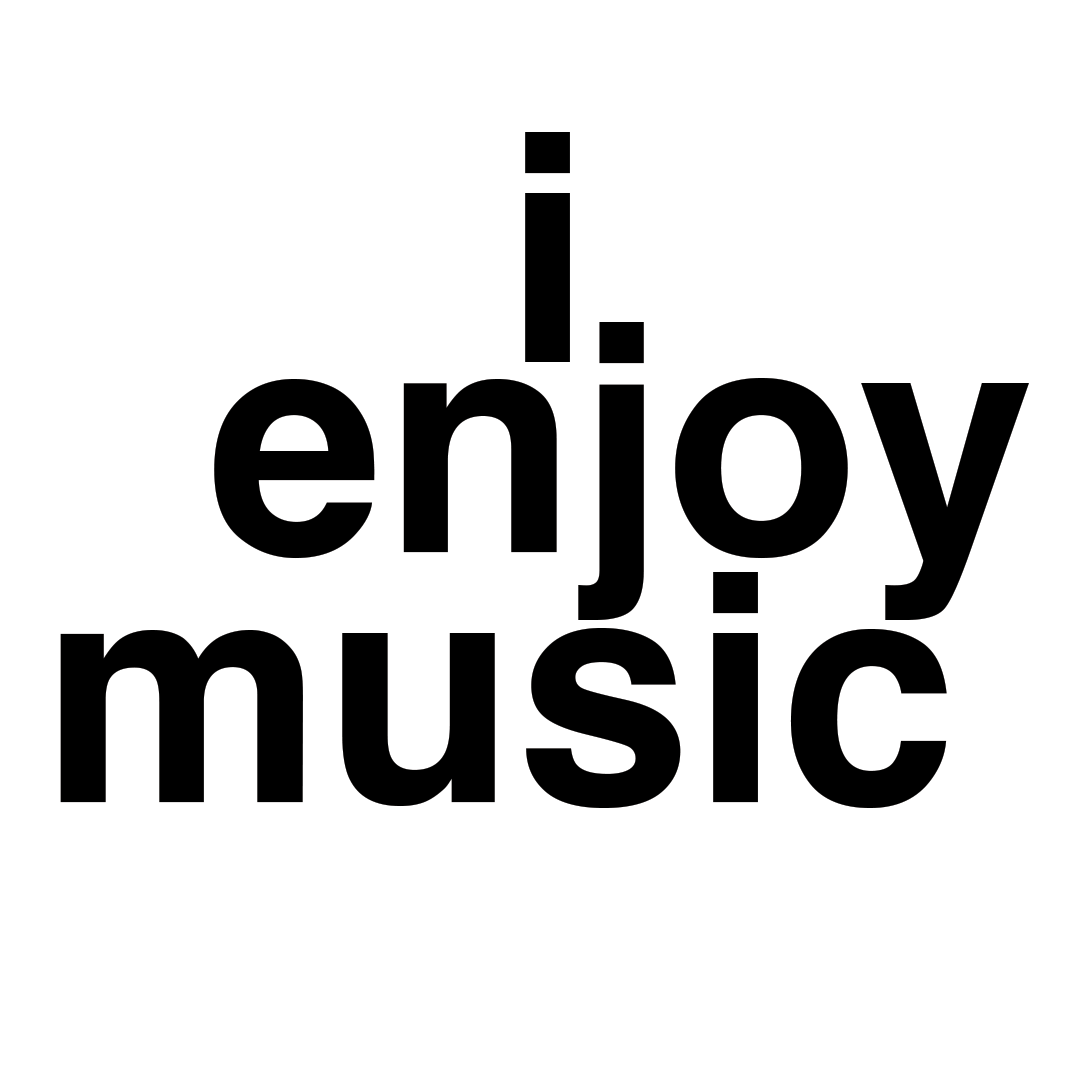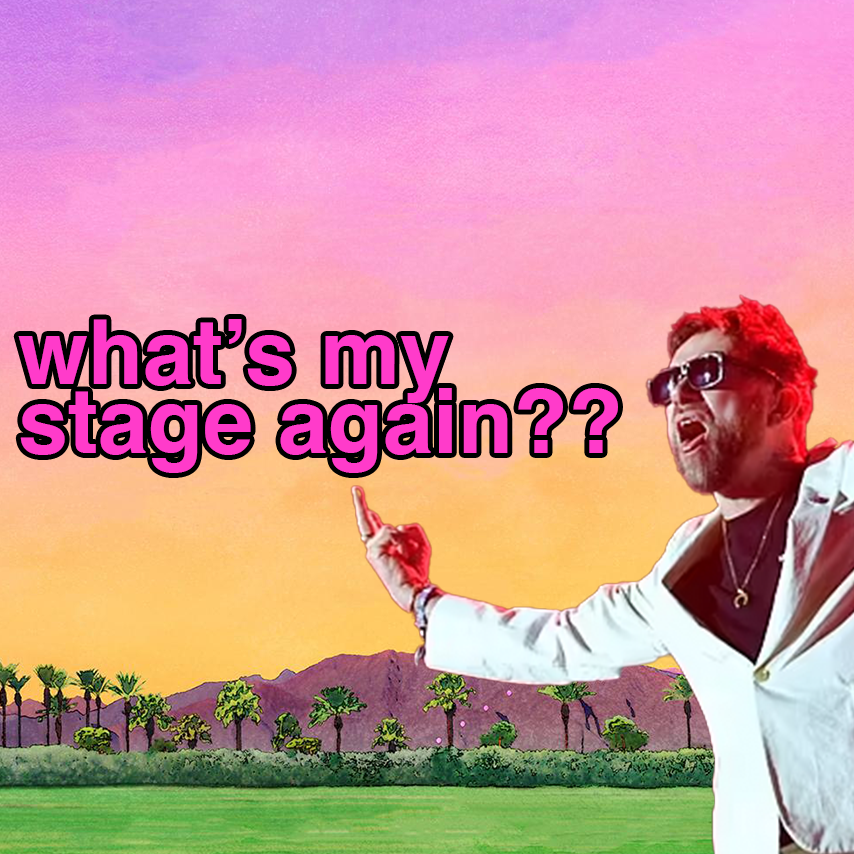
stray thoughts on "the main stage" and blur @ coachella
Coachella 2024's first weekend recently occurred. Music was performed in the desert. Audiences watched the music being performed. An even larger audience watched the performances streamed on YouTube. And Red Bull vodkas were on sale for twenty two dollars apiece. What's the deal with these premium energy drink prices? Don't they know it's our human right to go fast?
The question is, how thirsty are you? 👀
— Festive Owl (@TheFestiveOwl) April 13, 2024
📍#Coachella pic.twitter.com/pfBzUoexf9
Now, I'm on the record as a Coachella enjoyer. A Coachella enjoyer in the era of the festival's precipitous reputational shift! I went from 2016 to 2019, and then again in 2022 when it came back after peak Covid. That's post-expansion to two weekends, post-Flower Crown Era—the clichés about the festival had already calcified. And Coachella has still changed quite a bit from my first visit. In 2016, the slightly embalmed but still rockin' hair metal icons Guns N' Roses were headliners, which seems an unthinkable booking not even a decade later. (They were pretty great, and Duff McKagan was so foxy that he inspired me to start a podcast.)
But 2016 was already pretty much the end of Coachella's rock love affair. The following year, Beyoncé got booked, and the year after that she actually got to perform, and her performance was so good that it essentially broke the concept of Coachella. Almost 20 years of eclectic iPod-core curation, slayed in a single swoop by a singer in a yellow sweatshirt. Now LCD-esque bands get shunted to more explicitly nostalgic Goldenvoice festivals like Just Like Heaven, and the headliner slot of Coachella is a megastar Colosseum, meant for those at the top of the streaming pile—compare 2004 headliners Kraftwerk and Pixies, and 2022 headliners Billie Eilish and Harry Styles. How the fuck are we supposed to have fun fun fun on the Autobahn now??*
One of the bigger stories coming out of the weekend, besides Grimes' botched DJ set and the usual smattering of 'iconic' guest appearances, was Blur's lukewarm reception on the mainstage. The Twitter account "music struggles & wins" popularized a TikTok montage that showed Blur frontman Damon Albarn's mounting frustration with an apparent lack of audience participation:
this coachella crowd doesn’t deserve blur pic.twitter.com/xBpys9qnkP
— music struggles & wins (@musicstruggles1) April 15, 2024
A lot of people are blaming the Coachella crowds: they were too young to remember the heyday of Britpop, or they were Tyler, The Creator fans waiting for their fave to come on, or they just didn't enjoy fun, or whatever. Me, I would not blame the Coachella crowds. This was, more than anything else, a failure of scheduling. Yes, Blur has a long history of massive songs, and as Ian Cohen pointed out, they are still, 27 years after "Song 2" was everywhere, about twice as popular as boygenius on Spotify. And Blur has literally headlined Coachella before. I'm sure it stings a bit to get demoted from the top slot, and that ego was a factor in the scheduling decision.

But it was a terrible move to stick Blur on the main stage at primetime. As someone who has attended this festival in recent years, I will tell you why. The main stage of the largest music festival in the United States is...large. The stage is big, the screens are bigger, the swathe of land to enjoy the music from is wiiiide. The further back you are in the crowd, the more likely you are to encounter people who aren't very engaged with whatever's onstage. People might be talking to their friends, or sitting on the ground eating a slice of Spicy Pie, or trying to breathe through an MDMA come-up panic attack. It's a diffused atmosphere, much different than the walled-in environment of a tent.
The largest music festival in the United States also has many stages. Eight of them, including a brand new open-air dance zone. Plus there's another stage called the DoLab which has its own tantalizing lineup, and another stage called Heineken House that pulls in talent like T-Pain to perform.
The largest music festival in the United States is also incredibly well-run. This machine is well-oiled. I see a lot of complaints about how much tickets cost, but that money pays for top-notch infrastructure. I have gone to a decent number of music festivals, and for its size Coachella is far and away the best-appointed one in terms of security, medical staff, food and drinks, cleanliness, and general organization. This means the populace is pretty chill! Woodstock 99 is obviously the best example of what happens when infrastructure fails a deranged mob of music fans; people do get fucked up at Coachella, but I have never witnessed crowds get even remotely out of control. Mosh pits are polite, rowdiness is minimal.
All of these elements added up to disaster for the Blur boys. At the moment of their performance, the elder millennials with tasteful bicep tattoos might have been drawn to Oneotrix Point Never's set, and younger rock fans might have been piling into the Sonora tent to see The Red Pears and bar italia. Checkered Van-wearing nostalgics might have taken the opportunity between Sublime and No Doubt to go get some chicken tenders. The temperature dropped into the 60s. The Red Bull vodkas, if you recall, were $22. By the time they hit "Girls & Boys," Blur were probably playing to a diluted, chilly, civilized crowd. Definitely not the ketted-up birds and blokes tearing up the turf at Reading and Leeds that they might be used to.

This leads me to a pitch I have for future Coachellas. I do think the fest is at the precipice of losing its "too big to fail" status. Ticket sales this year were apparently quite soft, and issues like this Blur scheduling debacle show how crucial the curation element of a festival really is. During a 2024 of deeply homogenous lineups—the Killers are playing Gov Ball, Lollapalooza, Boston Calling, and the New Orleans Jazz Festival this year, all hail our glorious leader Mr. Brightside—a true tastemaking festival still has value.
So, my pitch: abolish headliners and kill the concept of a "main stage." No "headliners" on the bill whatsoever. Rejigger the entire festival experience, make all the poster letters the same size. Keep the large number of stages, keep booking artists of varying popularities, but give up trying to surgically geolocate the size and interest in any given artist. Give the festival a good taste of ego death. Kids love ego death!!
Coachella has already starting to subvert the meaning of 'headlining.' In 2022, before Kanye's abrupt departure promoted them to a classical mainstage slot alongside The Weeknd, the Scandi EDM knights of Swedish House Mafia were billed as "Returning to the Desert," and they appeared, somewhat strangely, at the bottom of the poster. The following year, former headliner Calvin Harris got the "Returning to the Desert" slot and played after nominal headliners Blackpink. This year, No Doubt, who played after Blur but before Tyler, The Creator, also had a bottom-poster slot—preceded by a curt "AND..." that cracked me up when I first saw it announced.
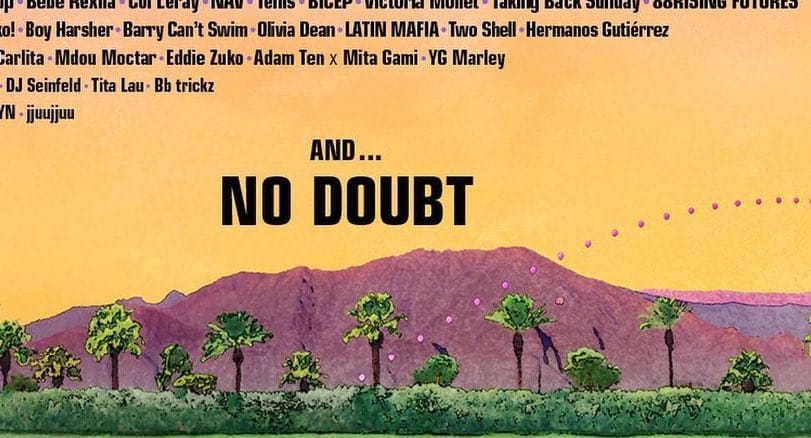
Blur bombing at 8:00pm on a Saturday night proves the usual hierarchy of set times and stage sizes might not fit this current confusing moment of swirling streaming numbers, "viral" songs, and evolving fandoms. And the most interesting moments of post-2012 Coachella have been departures from the norm: Kanye's meandering but amazing Sunday Service, the Fred again / Skrillex / Four Tet roundtable, left-of-center bookings like Hans Zimmer and Danny Elfman, Beyoncé's imperial march of hits. Coachella reinvented the American music festival for a new millennium, and I think they can do it again. They just have to be brave and open up the pit, just a lil bit.
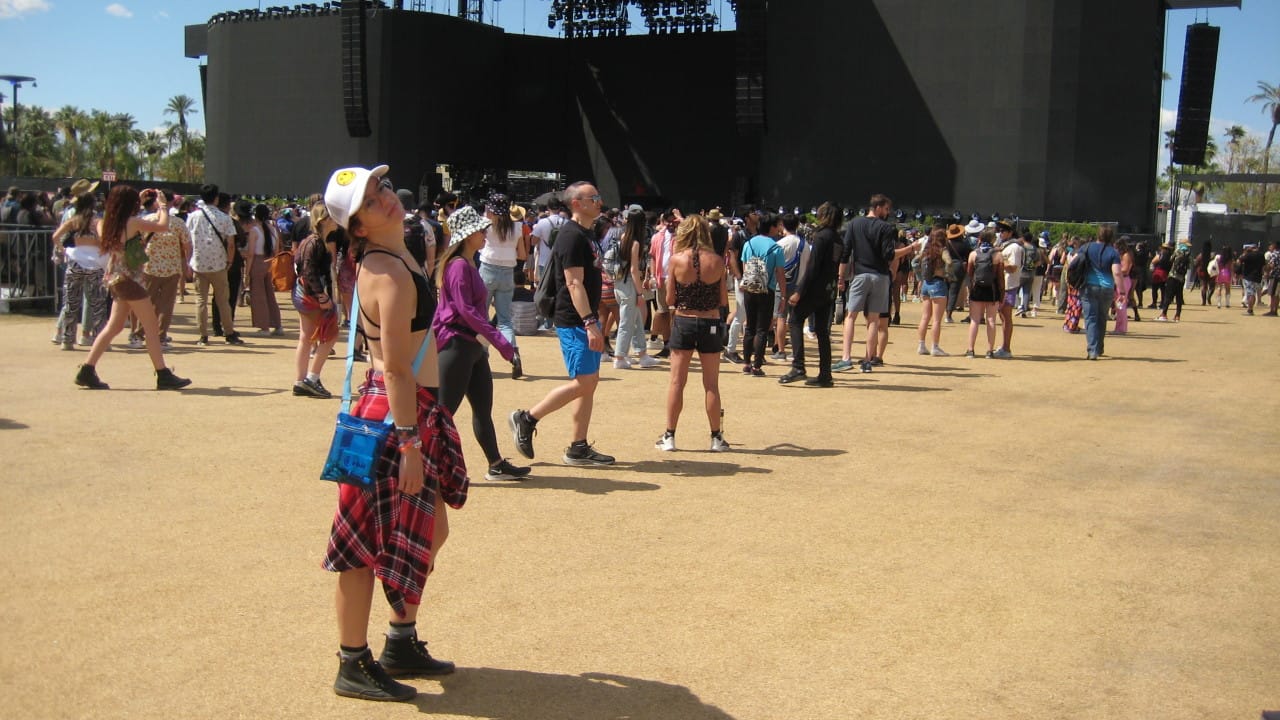
*nytimes style correction issued by my husband below...like a top chef contestant, i stand by my dish
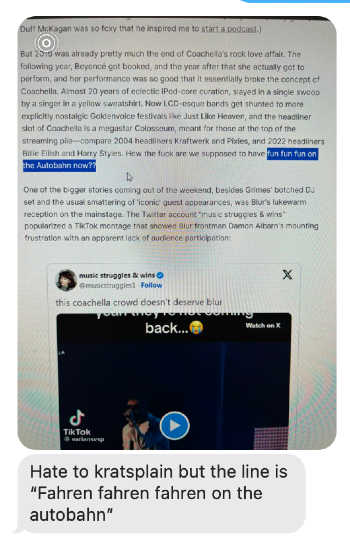
Thank u for reading I Enjoy Music. If you like it, tell a friend about it. Also, buy a button if you'd like a button.
